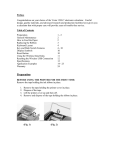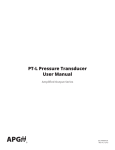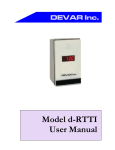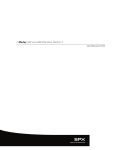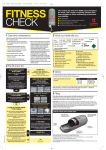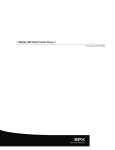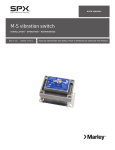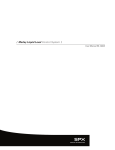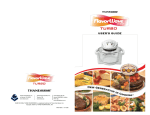Download Marley Ultra Low Noise Cooling Tower Fan User Manual
Transcript
/ Marley Ultra Low-Noise Fan / User Manual 07-1126 Contents General Information....................................................................... 4 Installation..................................................................................... 5 Operation..................................................................................... 11 Maintenance............................................................................... 13 Parts List..................................................................................... 16 Trouble Shooting......................................................................... 17 3 General Information Description The Marley Ultra Low-Noise series of fans represent the top in the new generation of super low noise fans—the FRP blades have been developed to meet the most stringent noise limitations. The fans permit variable pitch adjustment at standstill and feature a simplified design. Each blade is fixed to the hub with two bolted aluminum pillow blocks. Balancing When the rotor is dispatched in assembled form, each unit is dynamically balanced within a degree of G = 6.3 in accordance with ISO 1940/1. When the fan is dispatched disassembled, the hub is dynamically balanced and the blades are statically balanced so that the reassembled unit correspond to a degree of G = 6.3 in accordance with ISO 1940/1. In this case, the blades have the same static moment, so that they can be positioned in any order on the hub; the blades of the same supply, are interchangeable. Storage Upon unloading the fan, inspect it for any damage. If damage occurred, file a claim immediately against the carrier and mark the bill of loading accordingly. After the fan delivery, check the full compliance between order and delivered goods. Shortages or inconformities have to be reported within two weeks from receipt of shipment at destination. If not installed immediately, it is recommended to store the fan in a dry and shaded area, and do not put any heavy materials of any kind upon the blades. For long-term storage, it is necessary to check the condition of the corrosion preventive coating on all machined surfaces. 4 Installation Rotation and Flow Direction The rotation direction is correct when the airflow moves from the convex back (suction surface) of the blade, to the concave side (pressure surface). Figure 1 shows the conventional clockwise direction of rotation and normal direction of airflow as viewed from the discharge face of the rotor. Flow Direction Flow Direction Figure 1 Installation Instructions 1––Remove blade pillow block and fasteners 4, 5, 6, 7, 15 from the hub disk, one set a time (Figure 2). 2––If the hub has not been supplied already assembled to the flange, install the coupling flange 2 on the disk 3, complying with torque settings, bolt orientation, tightening order, and pins as shown in the table following Figure 2. 5 Installation 10B 9 10A 3 7 5 1 2 Figure 2 8 6 4 6 10 Installation Torque hub assembly bolts 11 according to the following table: Fan Diameter Flange Type inches 84" to 96" 108" to 168" Type 115 Type 190 Bolt Type Bolt Torque N·m ft·lb M16 cl. 8.8 230 169 M16 cl. A4-70 126 93 M16 cl. A4-80 168 124 M20 cl. 8.8 447 329 M20 cl. A4-70 246 181 M20 cl. A4-80 328 241 3––Hub into driveshaft installation (Figure 2). • As for the hub with cylindrical bore, the hub is bored to attach directly to the drive shaft. Coat the output drive shaft with a thin layer of silicon grease. If a space ring 10A is supplied, drive it into the drive shaft until it comes in contact with the drive shaft shoulder. Drive the hub with cylindrical bore into the drive shaft until it comes in contact with the drive shaft shoulder (or space ring shoulder if supplied). Warning Never power the drive shaft with special washer 16 and the retaining bolt 17 missing or loose. • As for the hub with tapered bushing hole, be sure drive shaft, bushing and hub bore are not greased. Slide the bushing into the drive shaft to your design position. Position the hub core over the bushing taper; insert bushing screws through the bushing flange into the threaded hole in the hub coupling; torque bushing screws according to the following table: Bushing Type Screw Torque N·m ft·lb Q1 and Q2 40 29 R1 and R2 40 29 7 Installation Caution Warning The drive shaft end must remain recessed at least 1⁄32" in the hub bore to prevent dangerous rotor vertical translation once retaining bolt 16 has been tightened to the shaft end. Never power the drive shaft with bushing bolts not torqued or bushing improperly positioned. 4––Install the blade. Sandwich the blade shank between the pillow blocks 4 and 5, ensuring both the pins 7 are in proper position (Figure 2). Fit pillow blocks 4 and 5, pins 7, pillow block plate 6, blade and pillow block fasteners 15 on hub disk as shown in previous Figure 3 without tightening bolts. Rotate fan to check tip clearance is in accordance with the specified value (tip clearance ratio x/D, where x = the distance from the blade tip to the fan ring and D = the rotor diameter). The gap between blade tip and fan ring must be measured along blade axis. Tighten the pillow block bolts 15, to hold the blade in extended position, leaving enough clearance to allow blade rotation on its own axis for pitch setting. 5––Setting blade pitch. The pitch angle of each blade has to be set at the A° value specified in the rotor identification plate with a 0.5° maximum tolerance: in order to set the pitch, the quotes shown in following Figure 3 must be observed; note these quotes are shown on the fan data sheet, and are specific for each diameter of the Marley Ultra Low-Noise fan. 8 Installation G X øH R T Z V S K D U øF øE øC Figure 3 FAN DIAMTER (A) Rotate the blade on its axis until the required pitch angle is obtained. Check there is no gap between each blade shaft shoulder and corresponding pillow block. Torque pillow block bolts 15 according to the following tables, complying with bolt orientation and tightening order as shown in Figure 4. Figure 4 1 3 4 2 4 Bolt Pillow Block Tightening Order 6––Repeat for each blade steps described in points 4 and 5. Before starting the pitch angle setting procedure, turn the fan till the blade to be set is at the same point in the fan ring where previous pitch angle was set. In order to determine the torque setting of standard bolts 15, with the 8.8 stamping, search in the following table the bolt type set for the diameter of the fan in object. 9 Installation Fan Diameter inches Note Bolt 15 Bolt Torque N·m ft·lb 84" to 96" M18 282.5 208 108" to 120" M20 400.3 294 132" to 144" M24 679.8 500 The screw class information is shown in the fan documentation part list. Stainless steel bolts 15 with the A4-80 stamping: Fan Diameter inches Note 10 Bolt 15 Bolt Torque N·m ft·lb 84" to 96" M18 175.6 129 108" to 120" M20 246.2 181 132" to 144" M24 425.7 313 In the case of a structure equipped with multiple fans, before setting the pitch angle to all the fans, set the pitch on one fan only and follow the instructions for operation starting on page 11. Operation Prior to Start-Up 1––Make sure all the pillow blocks are fixed to the hub boss—if any movement of the blocks is detected, do not operate the fan and check the torque of bolts 15. 2––Rotate fan to check tip clearance is in accordance with the specified value (tip clearance ratio x/D, where x = the distance from the blade tip to the fan ring and D = the rotor diameter). The gap between blade tip and fan ring must be measured along blade axis. 3––Check gear box oil level or belt tension to be as indicated by the manufacturer. 4––Remove all tools from the area. 5––Connect motor to power supply. 6––Start fan for a few seconds, and then switch it off. While the fan is still turning, check that the direction of the blade rotation is correct (see Rotation and Flow Direction). Post Start-Up 1––Check power absorption: if excessive, reduce the blade pitch angle until the desired power is achieved (set the new pitch on all the fans of a same structure); if lower than predicted, increase the blade pitch angle until the desired power is achieved (set the new pitch angle on all the fans of a same structure). Note Power absorption varies in inverse proportion to the air temperature. 2––Check the vibrations level in the position shown in Figure 5. Do not exceed the most restrictive amplitude values between the limits imposed by the normative of the structure where the fan is installed and the limits imposed by the VDI 2056 normative. In this case, shut down the unit and trace the cause of such excessive vibration by referring to section Possible Causes of Vibration in the following section. 11 Operation Figure 5 3––After the rotor has been running for one hour, check the torque of the hub screws 15. 4––Repeat the check of screws 15 after 24 hours from start-up. 12 Maintenance Maintenance and Operation 1––Inspect the overall fan condition periodically. Inspection intervals depend on fan operating conditions and may vary from a minimum of 2 weeks to a maximum of 6 months. The following components should be specifically inspected when inspecting the overall fan conditions: - Screw torque. - Fasteners corrosion. - General condition of blade surface. 2––Ice formation on the blades of operating fans must be strictly avoided. 3––If ice has formed on a stationary fan, it must be removed prior to start-up to avoid damaging the blades. Snow formed on a stationary fan must be periodically removed, according to the snow accumulation itself. 4––Turn off 2-speed motor for at least 30 seconds before switching to low speed. 5––Stop the unit completely before reversing the fan direction. 6––Check the vibrations level in the position shown in Figure 5 at regular intervals. The vibration level must not exceed the most restrictive amplitude values between the limits imposed by the normative of the structure where the fan is installed and the limits imposed by the VDI 2056 normative. In this case, shut down the unit and trace the cause of such excessive vibration by referring to page 14. It is advisable to keep a record of the readings taken on each occasion for comparison. Always take readings at the same positions and in the same manner. Observe the safety precautions insuring power supply is turned off. The fan vibration levels constitute an invaluable indication of the state of the plant and should be monitored frequently (e.g. monthly). Temperature Range This series of fans are designed to operate at these temperatures. Minimum is -20ºC (-4ºF) Maximum is +82ºC (+180ºF) 13 Maintenance Possible Causes of Vibration The actual causes of vibration may change considerably. Some of the most common are as follows. 1–– Unbalance of one or more blades: the vibration caused by blade imbalance occurs on the tip path plane with a frequency equal to the fan RPM and at an amplitude which is dependent on the degree of imbalance and the square of the rotational speed. 2––Blade pitch angle not included in the ± 0.5° tolerance: this condition causes vibration outside the tip path plane at a frequency equal to the fan RPM and at an amplitude which is dependent on the square of the rotational speed. 3–– Blades too close to supports (periodic aerodynamic turbulence): this condition is characterized by vibration outside the tip path plane at a frequency equal to the product of the number of fan blades and RPM. The amplitude depends upon the extent of the aerodynamic turbulence. 4––Resonance between one of the possible forcing frequencies of the fan and one or more of the vibration modes of the structure on which it is installed. The main forcing frequencies generated by the fan, normally correspond to the following frequencies: - Fan RPM - The product of fan RPM and the number of blades - The product of fan RPM and the number of structural supports capable of generating aerodynamic turbulence (if they are arranged in an axial-geometric fashion). 5–– Vibration transmitted by the structure on which the fan is installed: the frequencies of such vibration depend on both the external forcing frequencies and the resonant frequencies of the structure. 6––Resonance of the blades with one of the possible forcing frequencies; in the vast majority of cases the vibration occurs outside of the tip path plane. 7––Misalignment of the drive shaft: this generates vibration with a frequency that is once or twice the RPM. 8––Loosening of blade and/or speed reducer fixing bolts. The behavior of the rotor under these circumstances is totally unpredictable, as it depends upon the extent and location of the loosening. 14 Maintenance 9––Worn output shaft bearing: this condition generates vibration on the tip path plane at a frequency equal to the rotor RPM. 10––The fan and/of the structure bolts are not tightened: in this case all the bolts have to be tightened. 11––The draining holes of the blades are obstructed: they have to be opened. Note The amplitude of the fan vibrations is determined by the rigidity of its support. Vibration that would not be critical to a fan supported by a sufficiently rigid structure is amplified by an overly flexible support. This support rigidity may also cause unexpected variations in the resonant frequencies of the blades. 15 Parts List Item 16 Standard Protection 1 Blade FRP –– 2 Coupling Flange Steel Epoxy Paint 3 Hub Disk Steel Epoxy Paint 4 Lower Pillow Block Aluminum –– 5 Upper Pillow Block Aluminum –– 6 Pillow Block Plate Steel Epoxy Paint 7 Pins Steel Zinc Plated 8 Coupling Flange Washer Steel - R40 HDG 9 Coupling Flange Lock Washer Steel - R40 HDG 10 Note Standard Material Description Figure 6 Coupling Flange Nut Steel - 8.8 class HDG 10A Space Ring (if needed) Steel Zinc Plated 10B Taper Bushing (if required) Malleable Cast Iron Burnished 11 Coupling Flange Bolt Steel - 8.8 class HDG 12 Pillow Block Washer Steel - R40 HDG 13 Pillow Block Lock Washer Steel - R40 HDG 14 Pillow Block Nut Steel - 8.8 class HDG 15 Pillow Block Bolt Steel - 8.8 class HDG 16 Screw (not included) –– –– 17 Washer (not included) –– –– For special applications, materials and protective coatings could be different. In this case, make reference to the fan documentation. Parts List 11 8 15 12 6 2 5 1 16 17 16 4 7 3 12 13 14 8 9 10 Figure 6 10B 10A 17 Troubleshooting Trouble Cause Remedy System congestion. Clean the entire system. Check the real obstacles area and the inlet shape towards the original design. Obstacles to the air flow. In dry-coolers the minimum free height of the inlet area has to be 1 time the fan diameter at least; this height has to be higher in case of multiple units in line. Static pressure higher than the specified one. Increase blade pitch angle (till 3º after checking the data sheet selection. Pitch angle lowered by blade rotation (e.g. screw (15) not tightened at the right torque). Set the right pitch angle and refer to the operation manual to set the right torque of screws and bolts. Temperature higher than the design. Increase blade pitch angle (till 3º after checking the data sheet selection. Temperature lower than the design. Decrease blade pitch angle (till 3º after checking the data sheet selection. Static pressure lower than the design. Decrease blade pitch angle (till 3º after checking the data sheet selection. Screws and bolts of the fan and/or the structure loosened. Torque all screws and bolts. Fan not centered. Center the fan. Tip clearance too small. Increase the fan ring diameter. Unbalance of one or more blades. Contact SPX Cooling. Blade pitch angle not included in the 0.5º tolerance. Set right blade pitch angle. Blades too close to supports (periodic aerodynamic turbulence). Contact SPX Cooling. Low air flow Low power absorption High power absorption Rubbing between the blades and the fan ring Resonance between one of the possible forcing frequencies of the fan and one or Contact SPX Cooling. more of the vibration modes of the structure on which it is installed. High vibration level Vibration transmitted by the structure on which the fan is installed. Contact SPX Cooling. Resonance of the blades with one of the Contact SPX Cooling. possible forcing frequencies. Misalignment of the drive shaft. Realign of the drive shaft. Worn output shaft bearing. Contact the supplier. The fan and/or the structure bolts are not Tighten screws and bolts at the right torque. tightened. The draining holes of the blades are obstructed. 18 Open the draining holes. 7401 WEST 129 STREET | OVERLAND PARK, KANSAS 66213 UNITED STATES | 913 664 7400 | [email protected] | spxcooling.com In the interest of technological progress, all products are subject to design and/or material change without notice. ©2009 SPX Cooling Technologies, Inc. | Printed in USA M07-1126




















